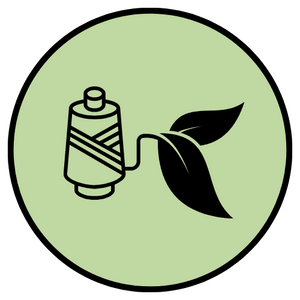What is Sustainable Fashion?
For decades, the fashion industry has followed a “fast-fashion” model of doing business. This essentially means a clothing brand’s primary focus is to identify new trends and get them to market as fast as possible. The production of clothing is not only rapid, but it is immense. The fashion industry is one of the largest industrial sectors in the world. Clothing is on the short list of basic human needs meaning everyone, everywhere in the world is wearing clothing of some kind. It is one of the few items that people need and buy regularly. This type of rapid, immense production model means sales and profits can supersede human welfare and quality. Consequently, fashion is considered the second most polluting industry in the world, only behind oil and gas, according to a 2019 UN News release, and it’s reasonable to assume that transitioning the fashion industry to a sustainable model would have a significant impact on the health of our planet.
“Fashion” is more than catwalks and trend boards. It is much more vast and complex than that. Fashion is a term that describes the entire supply chain used to produce clothing and accessories. It includes raw materials farmers, fabric suppliers, yarn dyers and spinners, manufacturing workers and factories, offices and warehouses, designers, marketers, packaging, shipping, sales and more.
In terms of fashion, the supply chain is typically separated into 5 tiers:
- Raw Materials Production (Cotton and Wool Farmers)
- Raw Materials Processing (Yarn Dying and Spinning)
- Manufacturing (Final Garment Manufacturing)
- Shipping & Packaging
- Stores & Offices (Designers, buyers, and physical storefronts)
It is important to understand the immense scale of the fashion supply chain in order to understand the issue of sustainable fashion. It is not a singular issue like plastic bags and microfibers in the ocean. It is more like a web of interconnected issues involving many businesses, entities and people around the world. The Center for Sustainable Fashion and The London College of Fashion teamed up to launch a digital course about sustainable fashion. Their course identifies the 8 key sustainability issues facing the fashion industry as:
1. Climate Change: The consequences of climate change, like rising sea levels and droughts will have a profound affect on the fashion supply chain.
2. Water Stress: Over 1 billion people currently lack access to clean water around the world and fashion consumes an embarrassing amount of water to create cheap clothing.
3. Hazardous Chemicals and Pollution: The fashion industry is one of the largest users of chemicals and in turn is responsible for high levels of air and water pollution.
4. Land Use and Biodiversity: Fashion is directly linked to habitat loss and a decline in biodiversity through land use. Maintaining a variety of plants and animals is the foundation for a healthy ecosystem.
5. Diminishing Resources: Fashion relies on many finite, natural and human resources.
6. Consumption and Waste: Clothing production has doubled worldwide since 2000, but people are keeping their clothes for half as long.
7. Modern Day Slavery: Modern Slavery exists in the fashion supply chain in the form of forced labor and child exploitation.
8. Wellbeing: The pace of fast fashion compromises the health and safety of everyone in the supply chain including workers, wearers and animals. The need for rapid production places profits over human welfare.
Recent developments in technology have shed light on the scale of these issues. It wasn't until the 2010’s the public started seeing an abundance of articles highlighting the damage of fast-fashion. Here are some of the alarming facts that have come to light in just the last 10 years:
-
According to a 2017 article by the World Resources institute, “The number of fashion seasons has increased from two a year – spring/summer and fall/winter – to as many as 50-100 microseasons.” -
According to the documentary released in 2015, The True Cost, the world consumes around 80 billion new pieces of clothing every year, 400% more than the consumption twenty years ago. -
A 2017 article by the World Resource Institute highlighted how damaging cotton t-shirts are on water stress
, as it requires 2,700 litres to make on cotton t-shirt. This is the same amount a single human intakes over 2 1/2 years. -
A 2018 US Department of Labor reportfound evidence of forced and child labour fueled by fast-fashion in Argentina, Bangladesh, Brazil, China, India, Indonesia, Philippines, Turkey, Vietnam and others. All these findings are just coming to light and gaining mainstream attention within the last 10 years. - An article by Vogue finds that "more than 40 garment workers have died in the MENA
region alone" in the months of February and April in 2021. -
A 2020 article by BBC finds a
round 85% of all textiles thrown away in the US– roughly 13 million tonnes in 2017 – are either dumped into landfill or burned.
If you like clean water and air, and you don’t like forced child labor, then these statistics should concern you. This is where the concept of Sustainable Fashion comes in. Sustainable Fashion is a fairly new term that spawned in response to Fast-Fashion. The growth of Sustainable Fashion mirrors the downfall of fast-fashion. As fast-fashion practices became more scrutinized throughout the 2010’s, the idea of Sustainable Fashion gained popularity. In the last ten years it has evolved from a fringe buzzword to the most influential trend in fashion today. Now you can google “Fast-Fashion Environmental Damage” and find dozens of articles detailing the disturbing impact rapid production and over-consumption habits have on our world.
Along with increased media attention, new technology like social media has also played a huge role in spreading the word of sustainable fashion, pushing the issue into the mainstream. Social media is emerging as an indispensable tool to share brand stories, create communities focused on sustainability, and sell/purchase sustainable products. As awareness grows about fast-fashion and over-consumption, people, especially younger generations, are starting to respond by changing the way they live and shop.
Consequently, the demand for Sustainable Fashion has grown steadily since 2015. An analysis done by The Business Research Company shows the market size for sustainable fashion "reached a value of nearly $6.35 billion in 2019, having increased at a compound annual growth rate (CAGR) of 8.7% since 2015. The market is expected to grow from $6.35 billion in 2019 to $8.25 billion in 2023 at a compound annual growth rate (CAGR) of 6.8%. The growth is mainly due to the growing awareness about using ethical fashion for sustainability.”
We are already starting to see progress as knowledge grows about Sustainable Fashion and the harms of fast-fashion. This graphic from EPA.gov shows how textile waste has already decreased significantly prior to 2015.
This is evidence of how important it is to continue to spread the word. Knowledge is power. The more people understand the damage of fast-fashion and over-consumption, the more progress can be made. Sustainable fashion is still new. Many people are unaware of the issue, and while some major brands and new start ups are taking the cause of sustainable fashion seriously, others are unfamiliar, uninterested or unsure how to start.
At Abode Outside this is our mission. We want to be a reliable source for sustainable fashion, but more importantly we want help transform the entire fashion industry into a more sustainable one. We want to be an example of how to do Sustainable Fashion the right way, and we hope to encourage shoppers and retailers to live more sustainably. Continue to educate yourself, spread the good word of Sustainable Fashion and stay tuned for more.
SOURCES:
- The Business Research Company. 2020, "Sustainable Fashion Market Analysis Shows The Market Progress In Attempt To Decrease Pollution In The Global Ethicalfashion Market 2020", Globe News Wire, https://www.globenewswire.com/news-release/2020/10/28/2116073/0/en/Sustainable-Fashion-Market-Analysis-Shows-The-Market-Progress-In-Attempt-To-Decrease-Pollution-In-The-Global-Ethicalfashion-Market-2020.html
- EPA. 2018, "Textiles: Material-Specific Data", https://www.epa.gov/facts-and-figures-about-materials-waste-and-recycling/textiles-material-specific-data
- Abigail Beall. 12th July 2020, "Why clothes are so hard to recycle", BBC. https://www.bbc.com/future/article/20200710-why-clothes-are-so-hard-to-recycle
- US Dept of Labor. 2018, "List of Goods Produced by Child Labor or Forced Labor" https://www.dol.gov/agencies/ilab/reports/child-labor/list-of-goods
- Deborah Drew and Genevieve Yehounme. 2017, "The Apparel Industry’s Environmental Impact in 6 Graphics", World Resources Institute. https://www.wri.org/insights/apparel-industrys-environmental-impact-6-graphics
- Cyril Villemain. 25 March 2019, "UN launches drive to highlight environmental cost of staying fashionable", UN News. https://news.un.org/en/story/2019/03/1035161
- Morgan, Andrew, Michael Ross, Lucy Siegle, Stella McCartney, Livia Firth, Vandana Shiva, and Duncan Blickenstaff. The True Cost. , 2015. https://truecostmovie.com/
- Emily Chan. 2021. "8 Years After the Rana Plaza Disaster, We Still Aren’t Doing Enough to Protect Garment Workers", Vogue. https://www.vogue.com/article/garment-worker-rights-protection-eight-years-after-rana-plaza
- Kering, London College of Fashion. 2019. "Fashion and Sustainability: Understanding Luxury Fashion in a Changing World", Future Learn. https://www.futurelearn.com/courses/fashion-and-sustainability









